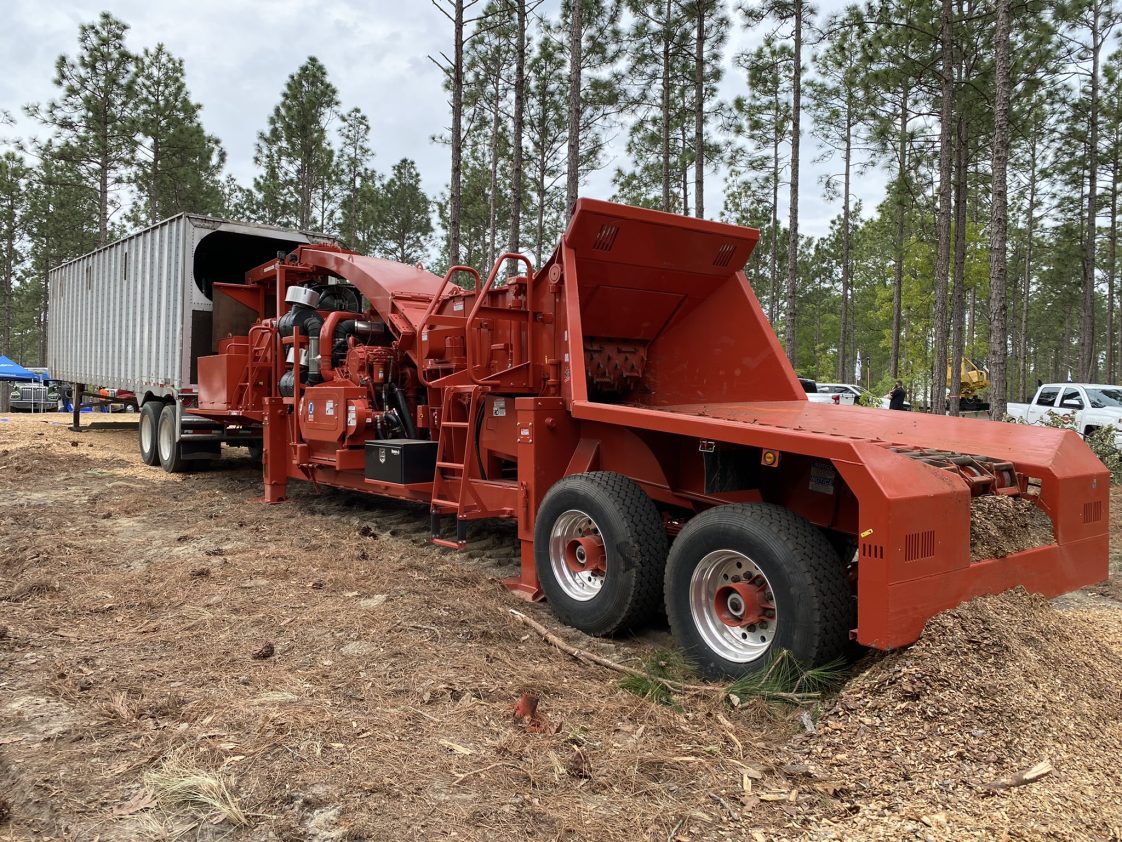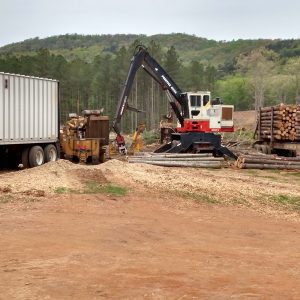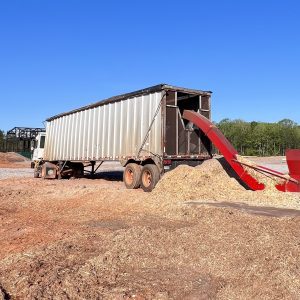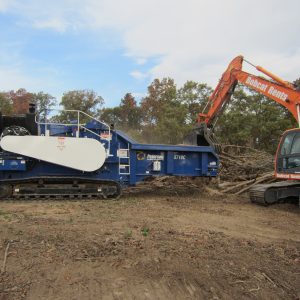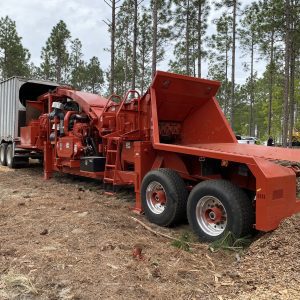Forestry

A woody biomass/energy chipping operation can be an additional source of income for Alabama landowners and loggers.
For those willing to learn or integrate energy chipping operations into their business, this publication provides essential information on chipping methods, primarily focusing on energy chipping. It covers common energy chipping techniques, equipment use, and factors that may affect the productivity of energy chipping operations. The information will help forest landowners and loggers plan their operations carefully and make informed decisions.
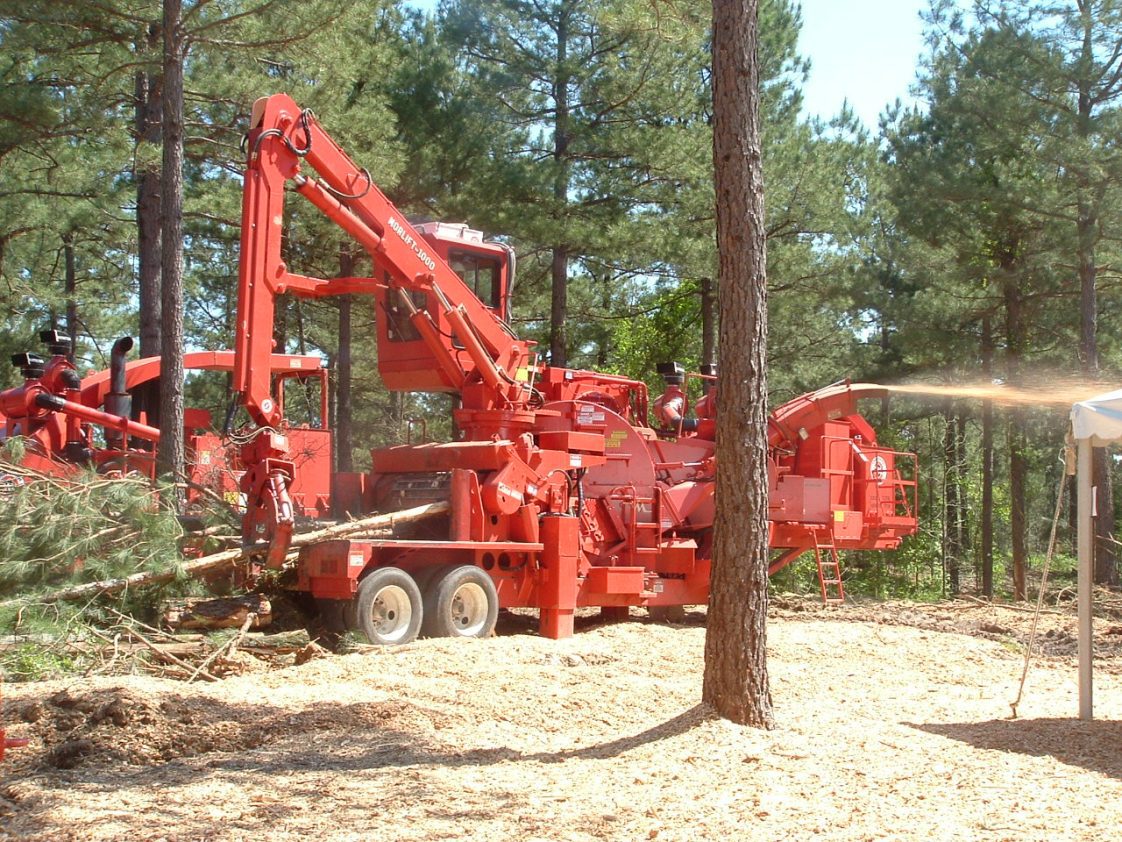
Figure 1. Morbark 2355 disc chipper (Photo Credit: Timothy McDonald).
Alabama is home to approximately 23 million acres of timberland, with 94 percent privately owned, as reported by the Alabama Forestry Commission. These forests are an abundant source of feedstock material for producing roundwood (dimensional lumber, plywood, etc.), pulp and paper, and energy. Depending on the desired end product, there are two types of wood chipping methods, clean chipping and dirty chipping (also known as woody biomass/fuel/energy chipping). The clean chipping method is used to produce chips for pulp and paper production, where wood is carefully chipped to produce high-quality chips with minimal bark and debris, meeting the required standards for papermaking. Disc chippers that also debark the materials (figure 1) have been commonly used in the woods to make clean chips for the past 30 years. In general, cellulose from both hardwood and softwood materials is used for clean chip production. The size of trees used mainly for clean chip production have smaller diameters of around 4 to 12 inches.
With the recent growing interest in renewable energy and production of bio-based products, there has been an increased focus on utilizing woody biomass for energy production. Woody biomass is any part of trees, such as branches, foliage, tops and limbs, and small diameter trees that are usually byproducts of silvicultural treatments (such as thinning and final harvest) left on site or burned at the landing. Traditional or conventional harvest methods can produce around 25 percent to 45 percent of woody biomass. Therefore, the primary purpose of the energy chipping method is to use woody biomass for energy production.
The energy chipping operations can be performed by integrating a wood chipper into a conventional roundwood harvesting operation or conducting in-woods whole-tree chipping. The equipment used remains consistent with conventional roundwood processes (feller-buncher, grapple skidder, loader, and delimber), with the addition of a chipper and a chip van at the log deck or landing. Integrating wood chipping with roundwood operations involves roundwood production and chipping logging residues, such as tops, limbs, and branches, which have traditionally been dispersed across the timber harvest site or piled and burned. Conversely, in-woods whole-tree chipping involves chipping the entire tree, with tops and limbs attached. Poor or highly dense stands that would not typically be harvested for roundwood can potentially be whole-tree chipped.
Woody biomass or whole trees are fed into the chipper using a loader (figure 2), and the resulting wood chips are then collected in chip vans (figure 3). Drum chippers efficiently produce energy chips (figures 4 and 5). Drum chippers use a cylindrical drum with horizontally mounted knives that cut the wood into chips as the drum rotates. They can handle demanding forestry tasks, such as efficiently processing large, dense wood tree species.
- Figure 2. Knuckle-boom loader processing trees and loading woody biomass into an in-woods chipper.
- Figure 3. A chip van collecting wood chips for transportation.
- Figure 4. Peterson 5710C whole-tree drum chipper.
- Figure 5. Morbark 4036 drum chipper.
Factors Affecting Productivity of Woody Biomass/Energy Chipping Operations
Location
Woody biomass chipping operations can be conducted at the deck/landing or a concentration yard. The decision of where to conduct these operations depends on several factors, such as the availability of space, type, condition of equipment, and distance to the concentration yard. Chipping operations at the deck/landing are often preferred as they make the most efficient use of space. One significant benefit is the ability to load chips directly into chip vans, which reduces the need for additional unloading and loading steps, saves time, reduces trucking costs, and potentially increases productivity. However, conducting chipping operations directly at the harvest site requires specialized equipment, usually a small, portable chipper. While these small chippers have the advantage of high biomass utilization potential, they come with limitations, such as lower engine power that can reduce productivity. Wheeled/tired chippers are common in the woods.
On the other hand, chipping operations at the yard are carried out with larger self-powered tracked chippers. Furthermore, transporting unprocessed material to the yard can increase transportation costs and require more extensive logistics to ensure a smooth operation from harvest to processing.
Size of Chipper
Selecting the appropriate size of the wood chipper is a crucial factor in ensuring the efficient completion of the job. Larger chippers equipped with powerful engines can handle bigger wood pieces and larger quantities, enhancing the overall chipping productivity. However, they require higher capital and operating costs and need more space. Conversely, smaller chippers are more economical and offer greater mobility and operational flexibility but have limited processing capacity and, as a result, lower productivity.
In Alabama, some of the most common small wood chippers include the Bandit 1890 and Bandit 1850, while the medium-sized chippers include the Bandit 2290, Morbark 3048, and Bandit 2590. Larger chippers include the Bandit 3090, Peterson 4300, Morbark 5048, and Peterson 6310. The engine power of these chippers can range from 200 horsepower for small ones to 800 horsepower for large ones.
Similarly, the price range of used chippers can vary from $50,000 to around $100,000 for small, $200,000 to $400,000 for medium, and $300,000 to $600,000 for large ones. The price of a new chipper can go up to $1.2 million depending on the size, power, and model specifications.
The size of the chipper and its engine power also influence the fuel consumption rate. Fuel consumption rate can range from 7 gallons per hour for small chippers to 25 gallons per hour for large chippers, depending on the horsepower.
Delays
Improving productivity in chipping operations requires more than just efficient chipping machines. It also involves reducing delay times, which can significantly impact the operation’s overall efficiency. One delayed component of the operation can slow down the entire process. Delays can arise from various personal and operational factors. Personal delays, such as breaks or communication issues among workers, directly affect the continuity and flow of the chipping process. Operational delays often occur due to machine interactions. For instance, delays may occur when waiting for chip vans to transport chips or when there is a lack of synchronization between the chipper and skidder. The skidder may experience delays when the chipper is full. The length of these delays can range from less than a minute to more than 32 minutes per load. Given the significant investments in harvesting equipment and chippers, minimizing delays is crucial for improving productivity.
Species Composition
Different types of trees exhibit varying characteristics and properties that influence the amount of power required for chipping operations. Hardwoods, which are usually denser, need more power and more frequent knife changes than softwoods, leading to lower productivity when chipping hardwoods. In contrast, softwood species yield higher chipping productivity. Pine chips are primarily utilized for pellet production, power generation, heating, and bio-oil production. However, they are not always suitable for pulp processes, such as papermaking and fluff pulp production because of their high bark content, which can compromise the quality of paper and pulp. Conversely, hardwood chips are preferred in producing high-quality paper, where they contribute to a smoother, brighter finish.
In the southern United States, the average price for in-woods whole-tree fuel chips, regardless of species, is around $29.50 per ton.
Piece Size and Tree Part
In the chipping operation, the size of the piece (length and diameter) is a crucial factor in determining productivity. Larger trees with greater diameters generally lead to higher productivity in chipping due to their more efficient processing, which enhances both the speed and volume of chipping. In contrast, chipping a greater number of smaller-sized trees tends to decrease productivity due to the increased handling and feeding time required. Chipping larger logs not only improves chipping productivity but also reduces the cost per unit of chipped material. However, it’s important to note that chipping large and whole trees can present challenges, such as dealing with heavy branching, which may require additional processing steps.
It is also worth noting that chipping the main stems of trees is about twice as productive as chipping the treetops. To improve productivity when chipping treetops, which are generally smaller and less uniform, feed multiple pieces at once. This approach helps to balance out the size discrepancy and increases overall productivity.
Moisture Content
Moisture content plays a crucial role in determining the efficiency of chipping operations. In the southern United States, freshly cut pine trees contain around 50 percent moisture content (on a wet basis). When the wood is moister, it is easier to chip. As the wood dries out, it becomes harder, increasing the wear and tear on the chipper knives. Chipping dry wood results in more dust, which can reduce visibility and affect the safety of deck/landing operations. The moisture content in wood varies depending on the tree species, age, and growth conditions. Younger trees and those in fast-growing regions generally have higher moisture content. Some species, such as the longleaf pine in the southern United States, have higher moisture content than other pines.
Conclusion
Different factors have an impact on the productivity of wood chipping operations. Even a slight change in one factor can affect the productivity and cost of the entire operation. Therefore, it is important for landowners and loggers to be aware of their objectives and choose the appropriate type of wood chipper. By carefully selecting the equipment and managing the operations, productivity can be enhanced while costs are minimized. This highlights the critical importance of informed decision-making in the chipping operation.
 Manisha Parajuli, Graduate Research Assistant; Richard Cristan, Extension Specialist, Assistant Professor, Forestry, Wildlife, and Natural Resources; Adam Maggard, Extension Specialist, Associate Professor, Forestry, Wildlife, and Environment; and Tom Gallagher, Professor Emeritus, all with Auburn University.
Manisha Parajuli, Graduate Research Assistant; Richard Cristan, Extension Specialist, Assistant Professor, Forestry, Wildlife, and Natural Resources; Adam Maggard, Extension Specialist, Associate Professor, Forestry, Wildlife, and Environment; and Tom Gallagher, Professor Emeritus, all with Auburn University.
New May 2024, Woody Biomass/Energy Chipping Operations in Alabama, FOR-2160

